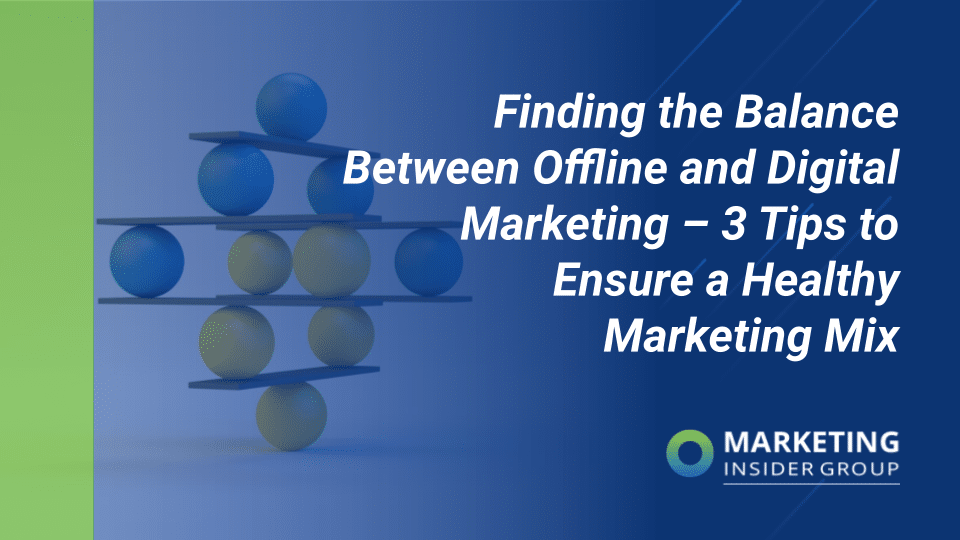
Finding the Balance Between Offline & Digital Marketing – 3 Tips to Ensure a Healthy Marketing Mix
Offline marketing is not dead. In fact, it’s never been more alive. The surge in digital marketing has brought enormous competition into the digital media market, which in turn drives up advertising cost. Digital spending is estimated to grow by 10% this year, despite some CEOs from both big and small brands agreeing that digital ads are a “waste of money”. It’s an interesting contradiction.
When allocating marketing budget to digital and offline channels, many marketing organizations are throwing in the towel with offline marketing. Let’s face it; digital marketing solves the Offline marketing complexities that many smaller marketing organizations are not set up to solve. Offline channels have complex operational schedules with significantly longer lead times and are difficult to measure. Both unique challenges make offline marketing a secondary choice to the more agile, lower-risk, easier-to-measure digital channels.
In the face of these challenges, the largest and most successful brands continue to invest in offline marketing. What is it these organizations know that the other organizations don’t?
The recipe consists of operations (the planning), measurement (the data), and organization (the people). Simple, but not easy. The below three tips are a surefire way to integrate digital and offline marketing and ensure your 2023 is successful.
Quick Takeaways:
- Focus on operations. Operational challenges often cause a lack of cohesion between marketing content across channels. With Offline decisions made months out and Digital decisions made at the moment, be sure to develop a well-defined content calendar & offer strategy to ensure inter-channel cohesion.
- Level the playing field with logical measurement. Many standard and straightforward attribution methods often favor digital but do not confuse demand collection for demand generation. Branded search is often a product of mass media, so be sure to include branded search when looking at non-digital ROAS.
- Minimize the labels within your marketing organization. Operational challenges and improper attribution methods often create silos between groups. Encourage your team to see themselves as marketers and as one team while fostering healthy competition between the groups.
Operations (the planning) – a well-defined content calendar & offer strategy:
Agility: the buzzword of the decade. In the digital marketing world, this is undoubtedly true. Offline, well, not so much.
Digital marketers can make changes on a dime. If something is not working, you pull it. If something is working well, you inject more spending into it. You can launch a multi-variate test in minutes (assuming you have the assets ready). There is no physical stock. Overall, the risk is minimal.
Offline marketers must be much more stringent. They buy media months, sometimes quarters ahead, the shelf life is long (and somewhat permanent), and the risk is high.
So, how can offline marketers compete if digital marketers want to change weekly, daily, or even hourly?
Here’s an example of what happens when these marketing channels each operate correctly but not cohesively:
Sam receives a flyer in the mail for a special offer. A 20% off coupon. Sam then goes on the website, and as many consumers do, they see the company is running a flash sale for $99 off. Problem. 20% off, $99 off.
We are in the decade of Twitter and TikTok – we have about 7 seconds to get the consumer’s attention and keep it. In this situation, the organization already lost Sam’s attention by asking them to overthink. We know that social media is not the cause of shrinking attention spans, but instead highlights the importance of storytelling and cohesion.
In this situation, it’s safe to assume the flyer was printed months ago, and the flash sale was a recent digital test that performed well. We can’t fault the digital marketers here because they’re doing what they should be – remaining agile in a test-and-learn environment. We also can’t blame the offline marketers – this is a product of the channel having longer lead times. So, how can this situation be avoided?
Operational excellence and a rock-solid content and promotional calendar. Spend a significant amount of time at the beginning of each year cultivating a content and promotional calendar. How much time? There is no singular answer here, but a marketing leader should spend as much time planning their team’s content and promotional calendar as the leader of the finance organization spends planning out the financial projections for the year. There will be a core content calendar that is the nucleus of both digital and offline, and it’s crucial to commit to that marketing calendar to avoid disruption.
While this is a crucial piece in your marketing plans for the year, it’s important you leave yourself some wiggle room. For instance, if you are going to run a flash sale, you can determine the amount later. It may be a percentage or a dollar amount discount, but that shouldn’t hold up your offline schedule. You can run it as a mystery sale and direct people to the website to claim their offer. This example is one way to navigate operational challenges with proper planning creatively, but there are countless combinations of ways to do so.
Measurement (the data) – leveling the playing field
Attribution. One of the most dangerous words in marketing. While numbers are important, you cannot throw out all instinct. It’s the middle of the vend diagram where numbers and instinct collide.
Digital measurement is constantly evolving. It’s complex on it’s own, but combining it with offline measurement creates additional complexities. As consumer behavior continues to shift in favor of digital, your attribution needs to get more intelligent. As marketers, we know that data is the primary key to measuring marketing returns.
Sometimes, though, we can turn a blind eye to the obvious in that data can often not consider the challenges of measuring offline marketing. When allocating a budget, it will be tempting to exhaust digital channels before giving media dollars to offline channels. A logical shift in mindset is separating demand collection vs demand generation. What’s the difference?
Let’s take branded search as an example. Instead of seeing it as a form of demand generation, shift to seeing it as a form of demand collection with the purpose of collecting the demand generated by another channel. In some ways, branded search is similar to an inbound phone call. In an ideal world, we would have enough inbound phone calls (or branded search) to drive the business without spending on marketing. We know, however, that it takes media to make the phone ring (or drive branded search).
Keep in mind that when looking at the returns of each channel, some channels only account for the direct expense for that channel. In this example, the branded search expense is only a fraction of what it takes to get someone to engage in that search. It’s much more than the cost of the click – but also the cost of the offline marketing that drives that behavior. Pair this with the difficulty in attribution and dividing up that marketing budget becomes a bit of a circular reference. The old school “it all works together” approach to marketing measurement has withstood the test of time, it’s presumably the least data-driven model and is purely instinctive. If we push 100% data, short-sighted decisions get made. Where’s the middle?
When stack-ranking the channels within your marketing organization, be very careful where the expenses and the revenue falls. Oftentimes with last click attribution the expense falls in one bucket and the revenue in another. What’s another way to look at this? Consider the correlation between media spending and branded search instead of the ROAS of branded search in and of itself. That’s step one.
Organizations (the people) – breaking down barriers between groups
The complex marketing operations and challenge to pinpoint attribution often leave digital and offline marketers jostling for departmental media dollars and recognition. After all, in performance-driven organizations, competition is critical. Digital marketers acknowledge the importance of offline marketing, as it acts as a source of traffic for their digital campaigns. The difficult issue is that the opposite is only sometimes true.
Each marketing leader should encourage their marketing organization to see themselves as just that – the marketing organization. Too often silos are put up between groups, and labels come about. Digital marketers are considered one team, offline another. While it’s good to foster competitiveness within the organization, remember that each channel can learn from another, and the principles of advertising apply across channels. Foster a community of marketers – without the channel as a label.
Putting These Tips to Use
Where to head next? Step 1 is ensuring your content and promotional calendar are ready for 2023. Then, focus on finding the middle of that Venn diagram when it comes to attribution. These can take time, but breaking down the barriers between groups can be started today. Remember, while your organization may view digital and offline marketing as two different groups, consumers don’t consciously see it this way. In the end, there are more things alike between the groups than there are differences, and the things that are different are solvable with the above tips in mind.
Are you looking for additional content on offline marketing? Here’s how to nail a yearly marketing calendar.






